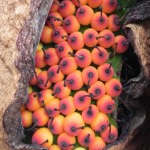Perry the Corpse Flower has surprised us yet again. I was disappointed with the small amount of pollen that I was able to collect during the July 2010 flowering event, and am now shocked at the apparent self-potency of whatever amount of said pollen was produced.
Here’s the story. I had not checked closely on the spent inflorescence for a couple of weeks, but had just been looking at it through the greenhouse window. I had been wondering why the base was remaining green, rather than browning and deshiscing from the corm for the onset of dormancy.
Yesterday afternoon, I was over at Gustavus for some mundane chores, and decided to check out Perry a bit more closely. A view from a side of Perry not visible through the greenhouse windows revealed bright orange-red berries! This was completely unexpected – normally, the female flowers become fertile before the male flowers, then become infertile before the male flowers produce pollen. It appears that perhaps the two phases overlapped this time, and that the huge number of houseflies that were attracted to the inflorescence managed to do a lot of pollination.
The flies even laid eggs in the inflorescence, producing some memorable visual images (especially after hatching began…). I’ll be posting some photos of that part of the Perry event, along with comments that visitors made about Perry’s fragrance (we had a book at the exit to the Perry Room in which visitors could write their impressions). Stay tuned for those blog posts over the next several weeks.
A concern with regard to setting fruit on Perry is that it stresses the plant a great deal, and can lead to death (but – with production of a great number of seeds). Only about 1/2 – 2/3 of Perry’s female flowers appear to have been pollinated, so we’re hoping that the reduced stress will allow survival (especially since Perry is such a robust plant). In the last photo above, one can see that about 1/5 of the flowers on the east side of the inflorescence have completely rotted. Yesterday afternoon I cleared away all of the dead parts of the inflorescence, so a pristine infructescence (no longer an inflorescence) is what we’re left with at this point. It will take several months for the berries to mature.




Dr. O’Brien – will this cause any problem being self pollinated? Since most of the time the pollination comes from a different plant.
Mavani aka Mavjot from the chat room
Hi Mavani,
It’s great to see that some of the chat roomers are still checking in! I posted this on AERGC-l, the greenhouse managers’ e-mail discussion list, and found there from Mo Fayyaz (University of Wisconsin, Madison) that some of their plants had done the same thing, and that the berries turned out to be sterile. We’re going to let the berries on Perry ripen, just in case we do get seeds (even if just a few). It will also be educational to watch the infructescence develop.
There’s another (though smaller) Amorphophallus titanum shooting up two leaves in front of Perry’s pot. You can see it on the still webcam, even though the live streaming webcam has been taken out.
Brian
Well isn’t Perry a sly dog there! I hope he survives this and is well and happy but I will admit to being glad to see it because I’ve wondered what the fruit would be like!
Hi Pamela – well, Perry is doing well, and the berries are getting larger. I’m planning to make a couple of blog posts soon, on Perry’s berries, Perry at Halloween, and visitors’ impressions of Perry’s fragrance.
Thank you for the information Brian , this is very interesting, but I hope Perry survives!
Lisa
Hi Lisa – Well, at this point, Perry seems to be surviving well, and the berries are getting larger. I’m planning some new blog posts soon.
Thanks for your comments, Pamela and Robin. The live streaming webcam has now been taken away, but you can still follow Perry’s progress via the still webcam (one photo per minute – but which might be slower at this point). We’ve put a vigorously-growing third plant of Amorphophallus titanum in front of Perry’s pot – it’s really taking off, and is a back-up for Perry (as is Georgia, whose leaf is now mature).